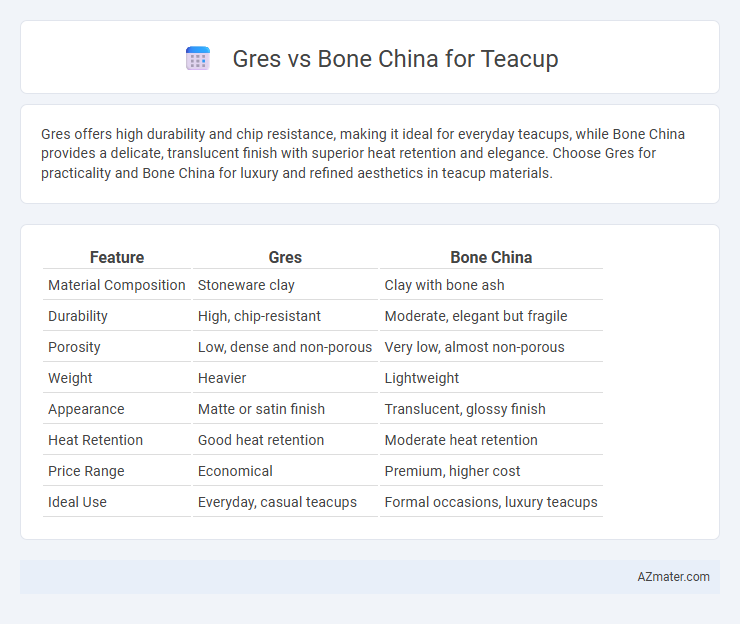Gres offers high durability and chip resistance, making it ideal for everyday teacups, while Bone China provides a delicate, translucent finish with superior heat retention and elegance. Choose Gres for practicality and Bone China for luxury and refined aesthetics in teacup materials.
Table of Comparison
| Feature | Gres | Bone China |
|---|---|---|
| Material Composition | Stoneware clay | Clay with bone ash |
| Durability | High, chip-resistant | Moderate, elegant but fragile |
| Porosity | Low, dense and non-porous | Very low, almost non-porous |
| Weight | Heavier | Lightweight |
| Appearance | Matte or satin finish | Translucent, glossy finish |
| Heat Retention | Good heat retention | Moderate heat retention |
| Price Range | Economical | Premium, higher cost |
| Ideal Use | Everyday, casual teacups | Formal occasions, luxury teacups |
Introduction: Gres and Bone China Teacups Compared
Gres teacups, crafted from high-fired stoneware clay, offer exceptional durability and a rustic, earthy appearance suited for everyday use. Bone china teacups are renowned for their translucency, lightweight feel, and elegant finish, made from a blend of bone ash, feldspar, and kaolin for superior strength and refined aesthetics. Choosing between gres and bone china teacups depends on preferences for robustness and rustic charm versus delicate elegance and fine craftsmanship.
Material Composition: What is Gres vs. Bone China?
Gres teacups are made from stoneware clay fired at high temperatures, resulting in a dense, durable material resistant to chipping and thermal shock. Bone china incorporates bone ash, kaolin, and feldspar, producing a lightweight, translucent, and highly durable ceramic known for its elegant appearance and delicate feel. The key difference lies in bone china's inclusion of bone ash, which enhances whiteness, translucency, and strength compared to the more robust and rustic composition of gres.
Aesthetic Appeal: Color, Finish, and Design
Gres teacups offer a rustic aesthetic with their earthy tones and matte or semi-matte finishes, appealing to those who favor natural, artisanal designs. Bone china teacups are prized for their translucent, smooth, and glossy finish, often showcasing delicate patterns and vibrant colors that enhance elegance and sophistication. The contrast between gres's understated, textured look and bone china's refined, polished appearance allows consumers to choose based on desired visual impact and decor style.
Durability: Strength and Chip Resistance
Gres teacups, crafted from stoneware clay fired at high temperatures, exhibit superior durability with enhanced strength and excellent chip resistance, making them ideal for everyday use. Bone china, while renowned for its delicate translucency and refined appearance, is comparatively more fragile and prone to chipping over time with frequent handling. For consumers prioritizing robustness and long-lasting wear, gres is the preferred material due to its toughness and resilience against impacts.
Weight and Feel: Handling Each Teacup
Gres teacups are heavier and offer a solid, sturdy feel, providing a substantial grip that appeals to those who prefer a weighty, durable vessel. Bone china teacups are lighter and more delicate, delivering a smooth, refined texture that enhances the sensory experience of sipping tea. The contrast in weight and feel affects handling, with gres favored for robustness and bone china prized for elegance and finesse.
Heat Retention and Tea Experience
Gres teacups excel in heat retention due to their dense, stoneware composition, keeping tea warmer for longer periods and enhancing the overall drinking experience. Bone china, while more delicate and lightweight, offers a thinner wall that allows the tea's aroma and flavor to be more pronounced, providing a refined sensory experience. Choosing between gres and bone china depends on whether heat retention or aromatic enhancement is prioritized in tea enjoyment.
Maintenance: Cleaning and Care Tips
Gres teacups are highly durable and resistant to scratches, making them easy to maintain with simple hand washing using mild detergent and warm water. Bone china requires gentle care to prevent chipping; use soft sponges and avoid abrasive cleaners to preserve its delicate translucency and intricate designs. Both materials benefit from avoiding extreme temperature changes and dishwashers to extend the lifespan and maintain aesthetic appeal.
Environmental Impact and Sustainability
Gres teacups, made from natural stoneware clays, offer superior durability and require lower firing temperatures, resulting in reduced energy consumption and a smaller carbon footprint compared to bone china. Bone china production involves animal bone ash and higher energy input during firing, raising concerns about resource intensity and ethical sustainability. Choosing gres teacups supports eco-friendly practices by minimizing raw material depletion and promoting longer-lasting products with lower environmental impact.
Price Comparison: Budget Considerations
Gres teacups typically offer a budget-friendly option due to their durable stoneware composition, making them ideal for everyday use without sacrificing quality. Bone china teacups, crafted from a refined blend of bone ash and porcelain, generally carry a higher price point reflecting their delicate translucency and premium craftsmanship. Choosing between gres and bone china hinges on balancing cost with desired elegance, where gres provides affordable robustness and bone china delivers luxury at a premium cost.
Conclusion: Which Teacup Material is Best for You?
Gres teacups offer exceptional durability and thermal retention, making them ideal for daily use and outdoor settings. Bone china teacups provide elegance, lightweight comfort, and superior translucency, perfect for formal occasions or collectors. Choose gres for practicality and robustness, while bone china suits those seeking refined aesthetics and delicate craftsmanship.

Infographic: Gres vs Bone china for Teacup
 azmater.com
azmater.com